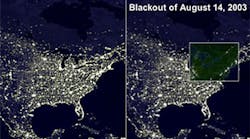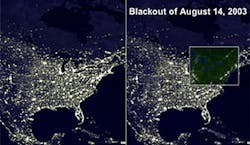Our local newspaper is asking readers where they were during the east coast blackout of 2003. At the time it occurred, 4:10 p.m. on Thursday, August 14, it was the second largest blackout the world had experienced. Some 45 million people in the United States were impacted along with 10 million Canadians.
I was working on the 20-something floor of a building in downtown Cleveland that day. I was on the phone when the lights went out, and not only was I scared (it was close enough to the anniversary of 9/11 to be concerning), I was ticked off that I was going to have to walk down 20 stories’ worth of stairs in high heels in the dark.
The city recently had rolled out an emergency response plan in the event of a natural or man-made disaster that entailed directing downtown workers to walk either far east or far west to empty out the area (this is if highways and streets were impassable by cars or public transportation). The plan required the people in the building where I worked to evacuate east, if necessary, even though I lived west, very close to the place where those working on the west side of downtown were supposed to congregate to catch buses out to perceived safety in the suburbs. As soon as I saw the plan, I realized I might be forced to evacuate to a location that would leave me stranded a number of miles from my home. My only option would ignore the plan (if possible) and walk home (about 3.5 miles).
Even though a crowded downtown left suddenly without electricity at the start of rush hour would seem to be the perfect time to implement the emergency plan, the city left us to our own devices. (This city is big on planning; short on execution.) This meant that many commuters endured an evening commute of 4-5 hours.
I was lucky; I was able to merge into traffic and although it took me half an hour to go about 12 blocks, once I reached the edge of downtown the remainder of my ride – governed by stop signs for the most part – took 5 minutes.
We were without power for a couple of days but thanks to a semi-Luddite mentality that included a 1950’s era telephone attached to a landline, a pantry filled with canned goods and a 1940’s gas stove that did not have an electric starter, we were able to make calls, boil water and cook food. For us, it was like camping out at home.
Without television and stereos, we sat on the front porch and talked to our neighbors and had cookouts with everyone's freezer food. As I live in a multi-cultural neighborhood, these cookouts resembled a block party, with a variety of food and live music that ranged from an unplugged salsa band to a classical guitarist to a jazz saxophonist. We were all a little sad when the lights came back on and the party ended.
Were you impacted by the Great Blackout of 2003? If so, please share what you were doing when it occurred and what you remember about the experience.

